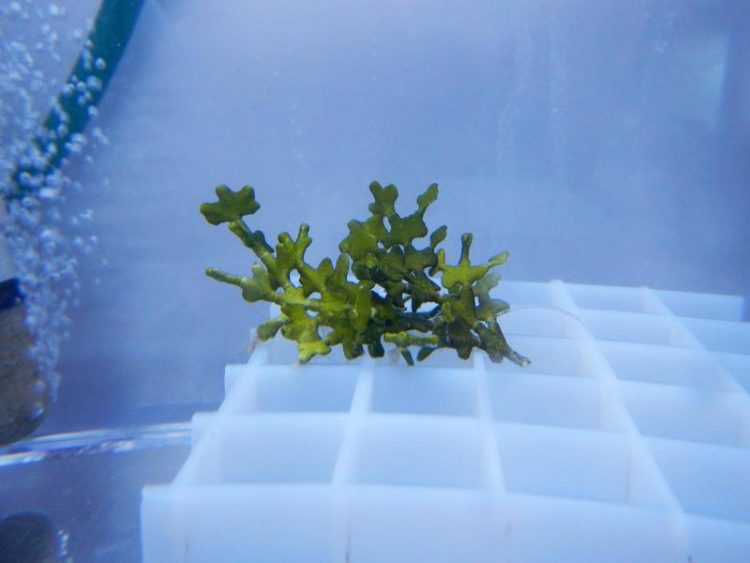Small Alga – Great Effect

Halimeda opuntia Photo: A. Wizemann, ZMT
The acidification of the oceans is increasing inexorably. In particular, marine organisms with calcareous skeletons such as sea shells, corals or calcareous algae can suffer. In a new study, scientists from the Leibniz Center for Tropical Marine Ecology (ZMT) in Bremen have noted significant changes in the calcareous skeleton of the green alga Halimeda as a result of a more acidic water environment.
These changes are an indication of the processes that occur at a lower pH level – that is, in more acidic water – in the skeleton of the calcareous alga. Since sandy beaches in many tropical regions largely consist of skeletal fragments of these algae, these changes may have an impact on the composition and formation of tropical beaches and islands.
In the seawater facility of the ZMT, the researchers exposed the Halimeda algae to water with a lower pH level, as may be found in many regions of the oceans 40 to 50 years from now. For the first time, the research group focused on the structure of the algal skeleton.
“While many studies on calcareous algae or corals have thus far only compared the quantity of calcareous skeleton produced at different pH values, we concentrated on the microstructure of the skeleton. For this purpose, we used our scanning electron microscope which can magnify the structures of animals and plants up to 100,000 times“, said biologist Andre Wizemann, one of the authors of the study.
As the researchers observed, the Halimeda alga forms a skeleton of fine calcareous needles, which are formed during the day at the cellular surface. At night these needles recrystallise – they partially dissolve and fuse to a dense, compact skeleton armor. Thus, the alga protects itself from predators and gains stability, so that it can survive at higher water flow, for example at the edges of coral reefs.
However, such a massive skeleton can only form if the calcium saturation in the surrounding water is high. At a lower pH level the content of calcium carbonate in the sea decreases. “In the algae from the more acidic water we mainly found just the fine needles which were formed by the algal cells. While the calcium production of the alga was not hindered, it lacked the solid support structure because the process of recrystallisation was disturbed,” said Wizemann.
The small Halimeda algae may not seem very spectacular at first glance. “In warmer coastal regions, however, the calcareous structures of the dead Halimeda algae are an important component of sediments,” Wizemann added. “On the Caribbean islands their skeletal parts can comprise up to 50% of the beach sand.” If their calcareous skeleton is weak and brittle, this can have far-reaching consequences. The fine calcareous needles dissolve more easily in water than a compact skeleton does. Therefore, not much remains of the algae after their death. This in turn could have a negative effect on the formation of tropical beaches and coral reef islands, which consist largely of calcareous sediments.
Publication
Wizemann, A., Meyer, F.W., Hofmann, L.C., Wild, C., Westphal, H. (2015). Ocean acidification alters the calcareous microstructure of the green macro-alga Halimeda opuntia. Coral Reefs 34(3), pp. 941-954. DOI: 10.1007/s00338-015-1288-9.
Media Contact
More Information:
http://www.zmt-bremen.deAll latest news from the category: Ecology, The Environment and Conservation
This complex theme deals primarily with interactions between organisms and the environmental factors that impact them, but to a greater extent between individual inanimate environmental factors.
innovations-report offers informative reports and articles on topics such as climate protection, landscape conservation, ecological systems, wildlife and nature parks and ecosystem efficiency and balance.
Newest articles

High-energy-density aqueous battery based on halogen multi-electron transfer
Traditional non-aqueous lithium-ion batteries have a high energy density, but their safety is compromised due to the flammable organic electrolytes they utilize. Aqueous batteries use water as the solvent for…

First-ever combined heart pump and pig kidney transplant
…gives new hope to patient with terminal illness. Surgeons at NYU Langone Health performed the first-ever combined mechanical heart pump and gene-edited pig kidney transplant surgery in a 54-year-old woman…

Biophysics: Testing how well biomarkers work
LMU researchers have developed a method to determine how reliably target proteins can be labeled using super-resolution fluorescence microscopy. Modern microscopy techniques make it possible to examine the inner workings…





















